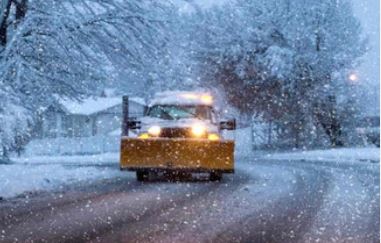What are some safety tips when driving near snowplows?
Snowplows make roads safer for everyone.
Unfortunately, collisions between snowplows and other vehicles are common.
A few states track snowplow crashes separately from other accidents. A report from the Virginia Tech Transportation Institute estimated more than a thousand crashes involving snowplows between 2012 and 2017 in Michigan.
When sharing the road with snowplows, drive defensively and cautiously. Snowplows operate in conditions with limited visibility, particularly if they’re driving in the snow or while it’s snowing. Snowplow drivers can also be driving long shifts in hair-raising conditions. They may be distracted, cold, tired, or all the above.

Should I pass a snowplow?
Passing snowplows is a bad idea. They may be driving very slowly, but you are always better off following a snowplow than driving in front of one because the road in front of them hasn’t been plowed yet!
Even if you have four-wheel drive, just let the snowplow do its job before you try to pass it. Some snowplows come equipped with specialized front and side plows. These side plows, called wing plows, jut out 10 to 12 feet on the side. If you pass a snowplow, you risk not clearing the plows, especially if visibility is limited.
How far should you stay behind a snowplow?
Snowplows must go about 35 miles per hour to do a proper job. The slow speed may make you impatient, but you must keep a safe distance behind them. Snowplows may need to stop or swerve abruptly to avoid obstacles, including stranded cars. They aren’t driving erratically, necessarily.
Drivers are up against unpredictable conditions, and if you’re driving behind them, you will be as well. Please keep a safe following distance in case they need to stop suddenly or back up.
How to keep your parked car safe from passing snowplows
You don’t necessarily need to be driving to get into a dangerous situation with a snowplow. If you have parked your car on the street, and you pause while clearing it off to get inside to warm up, passing snowplows could plow you back in. Except now, your car is running, and the snow could be blocking your tailpipe.
Now, instead of being able to exhaust fumes to the outside, the carbon monoxide backs up into the car. It can take a matter of minutes for the carbon monoxide to reach lethal levels, at which point you would pass out from the lack of oxygen.
Avoid this situation by clearing away all the snow around your tailpipe before starting your car. If there’s a lot of snow on the road, avoid situations where you might be sitting in a running car when a snowplow goes by. And if you do get plowed in, stay calm and immediately turn off the engine. You may need to exit your vehicle from another door if the driver’s side door is stuck or call for help if you’re trapped.

